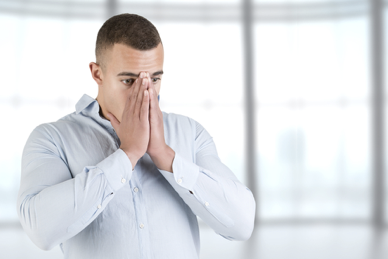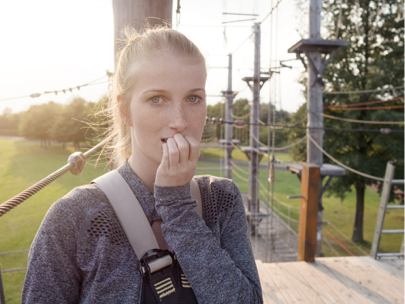17 Tips to Help Reduce Anxiety and Panic Attacks

People seek me out for many reasons. Anxiety is one of the top three reasons, alongside depression, and relationship issues.
In fact, at any given point in time, at least 20 percent of people are suffering from some type of anxiety.
What is anxiety?
Anxiety is actually a very normal but unpleasant reaction to one or more situations that may be causing you stress. Anxiety is an emotionally painful experience.
Anxiety often goes away, or at least lessens, when the person, place, or situation that causes you to feel fearful goes away.
One of the important things that I’d like you to understand is this: anxiety is usually a very normal reaction to anything that you experience as threatening. It only becomes a real issue if your normal coping mechanisms are so overwhelmed that you find it difficult to function in your daily living.
And, yes, most of us experience at least some anxiety from time to time. Me? Yep. I’m afraid of heights, being trapped in small confined spaces, and, oh yeah – going to the dentist! When I find myself in these situations, I use the coping tips below. But let’s look more at how many people suffer from anxiety, what causes anxiety and panic attacks, and get to know some of the common signs and symptoms we can experience when we feel anxious.
You are not alone
Over the course of a lifetime, at least 1 in 4 of us will experience one or more major episodes of anxiety…and that’s based on the number of people who are willing to report it. We don’t know how many more people suffer from anxiety and in silence.
What causes anxiety?
Outlining the cause of anxiety is vast and is beyond the scope of this particular article; it is important, however, to understand that the causes vary from one person to the next.
Having said that, science has shown us that there are usually multiple causes of anxiety including genetics, brain anatomy and physiology, personality traits, our social environments, specific people, and situations that can occur at home, at work, at school, or anywhere else for that matter, as well as past and current stressors that have been or are upsetting.
What is a panic attack?
Sometimes our anxiety becomes so intense that it seriously impacts our ability to function. When anxiety is really a problem is when we have panic attacks. It may be your first, or you may have been living with panic attacks for a long time. Even panic attacks can be seen as normal but unwanted reactions to a stressor – or even the fear of being exposed to a stressor.
A panic attack can occur when, for whatever reason, our anxiety completely overwhelms us. They can be triggered by almost anything that we associate with as frightening.
During a panic attack, your breathing may become short, shallow, and very rapid. You may feel intense shortness of breath…almost like you are gulping for air. You may begin to sweat. Your heart rate may increase as your body tries to compensate. Your skin may feel sweaty and flushed. But the most common sensation is that you feel out of control. I once had a full-on panic attack, so I know. It’s scary.
One of the major features of a panic attack is that once you experience a panic attack, you can develop anxiety about having another panic attack. We become afraid of another recurrence.
It was not enjoyable…but it did end. Here’s some comforting news. Panic attacks always end!
Above all, please know this: for whatever reason you are having a panic attack, it’s important to understand that you are not crazy. Again, you are simply a normal person, having a normal but upsetting reaction to something in the environment that scares you.
Now that we’ve identified what anxiety and panic attacks are let’s give you some tools to help deal with all of this.
Common signs and symptoms of anxiety and panic attacks
Here are some very common signs and symptoms associated with anxiety and panic attacks. No matter how unsettling anxiety is, assume that you are a normal person, having unpleasant but normal reactions to one or more triggers in your life. You may or may not be able to immediately identify the trigger.
Directions: Note the following signs and symptoms that apply to your situation. There are no right answers, only what is true for you. You may want to journal your list and add other specific signs and symptoms that tell you that you’re feeling anxiety.
- Rapid breathing
- Rapid heart rate
- Feeling dizzy, weak, or faint
- Chills, hot flashes
- Feeling terrified
- Chest pain
- Feeling that you are losing control
- Fear of recurring panic attacks
- Intense feelings and thoughts of dread
- Sweating
- Nausea
- Tingling or numbness in your fingers and toes
- Fear of dying
- Difficulty sleeping
- Avoiding situations that create anxiety but that you need to face, such as going to work, school, or social events.
Know your triggers
Research shows us that knowing our triggers can help significantly in reducing the number and frequency of panic attacks.
Here is the beginning of a list of triggers that may produce anxiety and panic for you.
We all have them!
I would encourage you to write down your triggers and use it as a reminder of the first signs of a panic attack.
Fear of recurring panic attacks
Fear of ____________________ (name of a person)
Fear of ____________________ (a specific situation such as flying)
17 proven tips that can help
Here are some tips to help you during a period of anxiety or during a full-on panic attack.
- Know your own signs and symptoms that are listed above. My clients have found that knowing their own specific signs and symptoms of anxiety has significantly increased their coping abilities. They know what to look for and aren’t as surprised when anxiety and panic hit.
- Develop a trigger list of people, things, and situations that tend to cause anxiety and stress. This can help you anticipate what might cause you to worry.
- Slow down your BREATHING. Focus more on deeper exhaling and shorten your inhaling. This reduces your oxygen intake. This is important because excessive oxygen radically intensifies panicky feelings. You want to slow down your breathing, especially the rate at which you are inhaling oxygen. Here’s another tip you can use to lessen your oxygen intake.
- Cup your hands over your mouth to reduce your oxygen intake. It’s a very simple method that many of my clients and friends have found very helpful.

- Breathe into a paper bag if one is handy. Many people have told me that this technique works as well if not better than cupping your hands.
- Count down from 100. Counting helps you shift your focus away from your anxiety. It’s a simple way to help distract your mind and potentially reduce your suffering.
- This is NOT your fault. You haven’t done anything wrong.
- Tell someone close to you what is happening. This is one of the most important things that you can do when experiencing anxiety in any form. I know. It can be embarrassing at first to disclose to a loved one that you are suffering. What people who experience anxiety have learned is that it is almost always helpful to talk about it, rather than hide it. Odds are, people around you have already noticed anyway.

- Practice self-love. Be patient and gentle with yourself.
- Keep in mind that your panic attack will always end. Remember this!
- Let people help you. In addition to telling someone about all of this, being open to getting help is certainly better than getting no help at all.
- Use mindfulness techniques. These are proven to reduce the frequency and duration of panic attacks for many people. Another word for mindfulness is meditation. There are a variety of ways to accomplish this.
- Create a playlist of music that is calming. Research clearly shows that the right music can be very helpful. Be picky about what you put on this list!
- Worrying has a purpose. It is rooted in our DNA and helps us to survive. Anxiety and worry are normal and important ways for us to protect ourselves. Yes. Anxiety is emotionally painful. It may also have something very important for you to learn from the experience.
- Find relaxing apps such as Calm for your smartphone and tablets. These work well in managing anxiety and may also help you sleep better.
- Promote your resilience. Unless these triggers pose an immediate threat to your safety, don’t avoid people, animals, and social situations that trigger your worry. You are going to encounter these situations in life. That’s understandable. However, if you avoid everything that worries you, then your anxiety will very likely worsen over time.
- Be patient with yourself. It takes a while to learn how to cope with anxiety! Learning to cope with anxiety takes a little practice, so please be gentle with yourself as you learn these techniques.
I hope that this article has been helpful for you or perhaps for a loved one who suffers from anxiety. If your anxiety persists, it may be time to seek professional help. There are many additional techniques that a trained therapist can offer you to help relieve your suffering. You deserve to feel better. Please feel free to contact me if you would like a free 15-minute phone consultation to see if I am a good fit to help you with all of this.
















11 Tips to Help You Cope with Rejection
[…] you’ve been all those nice things to others 13. Experiencing painful feelings of anxiety or a panic attack that may even stop you from engaging in life and with people who actually do like […]
Dating Anxiety in the Age of Tinder
[…] some information about anxiety in general. About 18% of American adults have been diagnosed with an anxiety disorder; that’s approximately 40 million people. Of that 40 million, social anxiety, in particular, […]
How Helicopter Parenting Impacts a Child’s Confidence
[…] child picks up on their parent’s anxiety and then becomes anxious themselves. She learns that she can only function with the help of a […]
Coping With The Holiday Season When You're Feeling Down
[…] if the stress and anxiety that comes with navigating finances and family at this time of year wasn’t enough, add seasonal […]